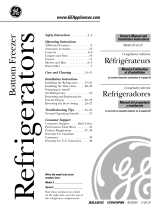Consumer Support Troubleshooting Tips
Operating Instructions
Safety InstructionsInstallation InstructionsTroubleshooting Tips Installation Instructions Safety Instructions
Operating Instructions
Troubleshooting Tips Installation Instructions Safety Instructions
Operating Instructions
Care and cleaning of the refrigerator.
6
Cleaning the Outside Cleaning the Inside
The recessed door handles
can be cleaned with
a cloth dampened with a solution of mild liquid
dishwashing detergent and water. Dry with a
soft cloth. Don’t use wax on the door handles.
Keep the finish clean.
Wipe with a clean cloth
lightly dampened with kitchen appliance
detergent. Dry and polish with a clean, soft cloth.
Do not wipe the refrigerator with a soiled
dishwashing cloth or wet towel. These may leave
a residue that can erode the paint. Do not use
scouring pads, powdered cleaners, bleach or
cleaners containing bleach because these products
can scratch and weaken the paint finish.
Protect the paint finish.
The finish on the outside
of the refrigerator is a high quality, baked-on
paint finish. With proper care, it will stay new-
looking and rust-free for years. Apply a coat of
kitchen/appliance wax when the refrigerator is
new and then at least twice a year.
Appliance Polish Wax & Cleaner is available
from GE Appliance Service and Parts Centers.
Inside the fresh food and freezer compartments
should be cleaned at least once a year. Unplug the
refrigerator before cleaning. If this is not practical,
wring excess moisture out of sponge or cloth
when cleaning around switches, lights or controls.
Use warm water and baking soda solution—about
a tablespoon of baking soda to a quart of water.
This both cleans and neutralizes odors. Rinse
thoroughly with water and wipe dry.
Other parts of the refrigerator‚ including door
gasket, vegetable drawer, ice trays and all plastic
parts, can be cleaned the same way. Do not use
cleansing powders or other abrasive cleaners.
To help prevent odors,
leave an open box of baking
soda in the rear of the refrigerator, on the top
shelf. Change the box every three months.
An open box of baking soda in the freezer will
absorb stale freezer odors.
Do not wash any plastic parts from your refrigerator in
your automatic dishwasher.
Defrosting—Freezer Compartment
■
■Defrost freezer compartment when frost
becomes 1⁄4″ to 1⁄2″ thick in any area of the
freezer.
■
■It may be necessary to defrost the freezer
compartment frequently if the freezer is used
often and/or there is high humidity.
NOTE: Do not use any electrical device or sharp
instrument in defrosting your freezer compartment.
To defrost freezer compartment:
Remove contents from freezer compartment
and turn temperature control to the
OFF
position. Temperature control must remain at
the
OFF
position and freezer compartment
door must stay open.
To reduce the amount of thawing of frozen
food while defrosting the freezer compartment,
store the food in a picnic cooler or other
insulated container.
Use a plastic scraper to loosen and remove
frost from the ceiling and walls of the freezer
compartment as the frost begins to thaw.
Do not use a sharp or pointed instrument to
remove frost—its use may result in damage to
the refrigerator system. To speed frost removal,
place pans of hot tap water in the freezer
compartment.
Sponge up defrost water as it collects in
bottom of freezer compartment. Place a large
folded bath towel at the front of the freezer
compartment to soak up water and prevent
it from running down the front of the
refrigerator.
After defrosting is completed, turn
temperature control to desired setting and
wait two hours before placing frozen food
back into the freezer compartment.
Defrosting—Fresh Food Compartment
Defrosting of the fresh food compartment takes place
automatically every time the refrigerator cycles off.
Melted frost water drains from the cooling plate
into a trough below the plate and down into
a pan near the bottom of the refrigerator (see
Defrost Water Pan section) where it evaporates.
NOTE: Be sure bowls or similar objects are not
touching the rear wall of the fresh food compartment.
If they are, frost may form on them and drip into fresh food
compartment during defrosting.
















